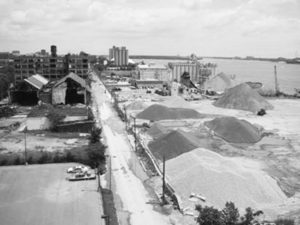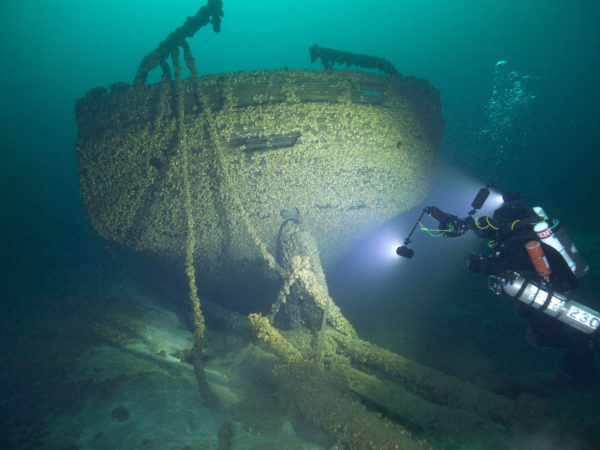
Great Lakes Moment is a monthly column written by Great Lakes Now Contributor John Hartig. Publishing the author’s views and assertions does not represent endorsement by Great Lakes Now or Detroit Public Television.
It was 1989 and I was attending a meeting on the 17th floor of Tower 600 of the Renaissance Center in Detroit that faces east and upriver towards Belle Isle. It was a striking view of material storage piles, surface parking lots, dilapidated warehouse buildings, and three sets of cement silos. I couldn’t help but think that these cement silos were like sentinel soldiers standing guard on Detroit’s east waterfront that had long lost its industrial glory. Even though much of the industry had long left this waterfront district, these sentinel soldiers were remaining true to their orders given many decades before.
For well over a century Detroit was an industrial town and had a working riverfront that supported industry and commerce. However, times had changed. There were fewer people and industries, and much underutilized and undervalued riverfront land. Detroiters had long lost their connection to the Detroit River. By the 1990s, they began to rediscover their river because of cleaner water and wanted to improve public access to it and redevelop it in a fashion that would improve quality of live, catalyze economic development, and help change the perception of Detroit from that of a Rust Belt city to one that is actively engaged in sustainable redevelopment.
There were numerous historical attempts in Detroit to create a more open and accessible riverfront, starting with Detroit Mayor Hazen Pingree who in 1889 proposed a plan for an extended park along Detroit’s riverfront. However, all of them failed.
Then in 2001 four significant things happened that would provide a foretaste of a future riverfront greenway:
• General Motors completed a $500 million renovation of the Renaissance Center, switching the front door from facing Jefferson Avenue to facing the Detroit River with the construction of a five-story glass atrium called the Winter Garden;
• Community Foundation for Southeast Michigan launched its Greenways Initiative that had raised $25 million to be given away in grants to communities to help make match requirements on federal and state greenways grants;
• United Auto Workers and General Motors opened a 65,000-square foot UAW-GM Training Center that provided a riverfront greenway easement; and
• Detroit celebrated its 300th anniversary that included restoration of Campus Martius Park as its legacy project of Detroit 300 and placement of an Underground Railroad Monument on the riverfront.
Together, these four significant developments gave further traction to the desire for a connected riverfront greenway and gave confidence to the City of Detroit to bring key stakeholders together to create an organization that would lead the effort.
In 2002, the City of Detroit commissioned a Blue-Ribbon Committee to develop a new vision for Detroit’s riverfront as a gathering place for Detroiters, their families, friends, and visitors. That same year, the Kresge Foundation committed $50 million in a series of challenge grants over a five-year period to help build a Detroit RiverWalk, the largest gift at that time in the history of the Foundation.
In direct response to the work of the Blue-Ribbon Committee, the $50 million commitment of The Kresge Foundation, and support of General Motors Corporation, the Detroit Riverfront Conservancy was established in 2003 as a nonprofit organization whose mission was to develop public access to Detroit’s riverfront and to have this development serve as an anchor for economic revitalization. After more than a century of trying, a Detroit RiverWalk was finally becoming a reality.
The goal is a continuous 5.5-mile RiverWalk from the MacArthur Bridge to Belle Isle to the Ambassador Bridge to Canada. The East Riverfront portion is 90% complete and already has nearly three million annual visitors.
My new book, titled “Waterfront Porch: Reclaiming Detroit’s Industrial Waterfront as a Gathering Place for All,” is the story of building the Detroit RiverWalk as part of a strategy to reconnect people with nature, help revitalize the city and region, and help foster a more sustainable future. Detroit was the epicenter of the Fur Trade Era, an unparalleled leader of ship building for 100 years, the “Silicon Valley” of the industrial age, and the unquestioned leader of the Arsenal of Democracy.
Today, Detroit is once again demonstrating its creativity, innovation, and work ethic in building the Detroit RiverWalk, and leading the nation down a more sustainable path.
If you are interested in getting involved in the Detroit Riverfront Conservancy, visit: https://detroitriverfront.org/waystohelp. If you are interested in learning more about this story of one of the largest, by scale, urban waterfront redevelopment projects in the United States that will give hope and will help provide further evidence that Detroit has a bright future, visit: http://msupress.org/books/book/?id=50-1D0-4543#.XMeS-2hKjIU
Editor’s Note: Great Lakes Now Contributor John Hartig is a board member at the Detroit Riverfront Conservancy.





